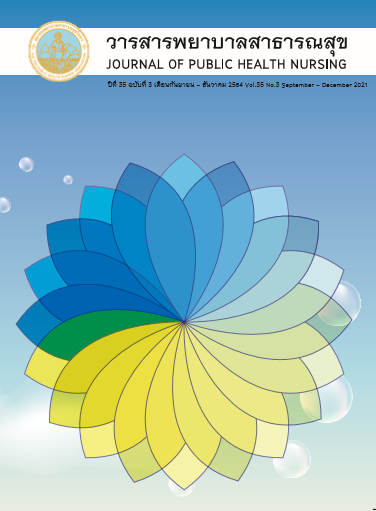A Causal Model of Illness Perception and Change of Lifestyle Behaviors on Blood Pressure in Thais with Hypertension
Keywords:
Illness perception, Hypertension, ThailandAbstract
Currently, a causal model between Illness perceptions and lifestyle modifications on blood pressure in Thais with hypertension in normal circumstance had not been examined. This study aimed to examine the direct and indirect effects of illness perception, lifestyle modification, and involved factors on systolic (model 1) and diastolic (model 2) blood pressures, using available data from a previous study conducted in 2015 among 660 Thais with hypertension from 4 Bangkok Public Health Centers and 2 primary care units. Data were analyzed using descriptive and path analyses. The results showed that both model 1 or systolic blood pressure model (Chi-square= 31.86, df= 35, p-value=0.620, RMSEA= 0.000, CFI=1.00, and GFI= 0.99) and model 2 or diastolic blood pressure model (Chi-square= 39.46, df= 35, p-value=0.277, RMSEA= 0.014, CFI=1.00, and GFI= 0.99) fitted with the evidence-based data. There were direct effects of illness perception with systolic and diastolic blood pressures. More exercise benefited with lowering systolic but not for diastolic blood pressures. Medication compliance benefited with lowering systolic and diastolic blood pressures. There was a difference between genders on diastolic blood pressure. This study indicated that Illness perception, exercise, and medication compliance were important for controlling high blood pressures
References
World Health Organization. Hypertension care in Thailand: Best practices and challenges. Nonthaburi: World Health Organization, Thailand; 2019.
Kaplan NM, Victor RG. Kaplan's clinical hypertension. Philadelphia, PA: Wolters Kluwer; 2015.
World Health Organization. Hypertension [Internet]. 2021 [cited 2021 October 1]. Available from: https://www.who.int/news-room/fact-sheets/detail/hypertension.
Ikeda N, Sapienza D, Guerrero R, Aekplakorn W, Naghavi M, Mokdad AH, et al. Control of hypertension with medication: A comparative analysis of national surveys in 20 countries. Bull World Health Organ 2014; 92(1): 10-9. Doi: org/10.2471/BLT.13.121954
Aekplakorn W. The fifth health examination survey of Thai population, 2014. Nonthaburee: Auksorn Graphic and Designs; 2016.
Arnett DK, Claas SA. Omics of blood pressure and hypertension. Circ Res 2018; 122(10): 1409-19.
Deere BP, Ferdinand KC. Hypertension and race/ethnicity. Curr Opin Cardiol 2020; 35(4): 342-50.
Buford TW. Hypertension and aging. Ageing Res Rev 2016; 26: 96-111. Doi: org/10.1016/j.arr.2016.01.007
Tan JP, Cheng KKF, Siah RC-J. A systematic reiew and meta-analysis on the effectiveness of education on medication adherence for patients with hypertension, hyperlipidemia, and diabetes. J Adv Nurs 2019; 75(11): 2478-94.
Leng B, Jin Y, Li G, Chen L, Jin N. Socioeconomic status and hypertension: A meta-analysis. J Hypertens 2015; 33(2): 221-9.
Zhang Y, Hou L-S, Tang W-W, Xu F, Xu R-H, Liu X, et al. High prevalence of obesity-related hypertension among adults aged 40 to 79 years in South West China. Sci Rep 2019; 9(1): 1-8.
Medina C, Jauregui A, Hernandez C, Shamah T. Physical inactivity and sitting time prevalence and trends in Mexican adults. Results from three national surveys. Plos One 2021; 16(7): e0253137. Doi: 10.1371/journal.pone.0253137.
Puddey IB, Mori TA, Barden AE, Beilin LJ. Alcohol and hypertension-New insights and lingering controversies. Cur Hypertens Rep 2019; 21(10):79.1-10. Doi: org/10.1007/s11906-019-0984-1
American College of Cardiology. Guideline for the prevention, detection, evaluation, and management of high lood pressure in adults: Guidelines made simple [Internet]. 2017 [cited 2021 October 1]. Available from: https://www.acc.org/~/media/Non-Clinical/Files-PDFs-Excel-MS-Word-etc/Guidelines/2017/Guidelines_Made_Simple_2017_HBP.pdf
Leventhal H, Brissette I, Leventhal EA. The common-sense model of self-regulation of health and illness. In: Cameron L, Leventhal H, editors. The self-regulation of health and illness behavior. New York, NY: Routledge; 2003. p. 42-65.
Leelacharas S, Kerdonfag P, Chontichachalaluk J, Sanongdej W. Illness perceptions, lifestyle behaviors, social support, and cardiovascular risks in people with hypertension in urban and rural areas of Thailand. Pac Rim Int J Nurs Res 2015; 19(3): 245-56.
Stallings DT. Illness perceptions and health behaviors of black women. J Cardiovasc Nurs 2016; 31(6): 492-99.
Shakya R, Shrestha S, Gautam R, Rai L, Maharjan S, Satyal GK, et al. Perceived illness and treatment adherence to hypertension among patients attending a tertiary hospital in Kathmandu, Nepal. Patient Prefer Adherence 2020; 14: 2287-300. Doi: 10.2147/PPA.S270786
Gomez-Cano M, Wiering B, Abel G, Campbell JL, Clark CE. Medication adherence and clinical outcomes in dispensing and non-dispensing practices: A cross-sectional analysis. Br J Gen Pract 2021; 71(702): e55-e61.
Tongnuage P, Jittanoon P, Boonyasopun U, Balthip K, Lauver DR. A causal model of lifestyle modification behaviors in Thai adults with hypertension. Walailak J 2017; 16(8): 561-71.
Namwong A, Panuthai S, Suwanprapisa S, Khamposiri T. A causal model of adherence to therapeutic regimens among Thai older adults with hypertension. Pac Rim Int J Nurs Res 2015; 19(2): 107-21.
Kline R. Principles and practice of structural equation modeling. New York: Guilford Press; 2016.
National Heart Lung and Blood Institute. JNC 7 Express: The seventh report of the joint national committee on prevention, detection, evaluation, and treatment of high blood pressure Bethesda, MD: National Institutes of Health; 2003.
Broadbent E, Petrie KJ, Main J, Weinman J. The brief illness perception questionnaire. J Psychosom Res 2006; 60(6): 631-7.
Leelacharas S. Illness representations in Thai women diagnosed with hypertension and relationships to medication-taking behavior [Doctor of Philosophy]. USA: University of Michigan; 2005.
Kim MT, Hill MN, Bone LR, Levine DM. Development and testing of the Hill-Bone Compliance to High Blood Pressure Therapy Scale. Prog Cardiovasc Nurs 2000; 15(3): 90-6.
Krousel-Wood MA, Muntner P, Jannu A, Desalvo K, Re RN. Reliability of medication adherence measure in an outpatient setting. AJMS 2005; 330(3): 128-33.
Lambert EV, Steyn K, Stender S, Everage N, Fourie JM, Hill M. Cross-cultural validation of the Hill-Bone Compliance to High Blood Pressure Therapy scale in a South African, primary healthcare setting. Ethn Dis 2006; 16(1): 286-91.
Alpsoy S. Exercise and hypertension. In Physical exercise for human health. Singapore: Springer; 2020. p.153-67.
Yue Z, Bin W, Weilin Q, Aifang Y. Effect of medication adherence on blood pressure control and risk factors for antihypertensive medication adherence. J Eval Clin Pract 2015; 21(1): 166-72.
Reckelhoff JF. Androgens and blood pressure control. Mayo Clin Proc 2019; 94(3): 536-43.
Downloads
Published
How to Cite
Issue
Section
License
บทความที่ตีพิมพ์และแผนภูมิรูปภาพถือเป็นลิขสิทธิ์ของวารสารพยาบาลสาธารณสุข (Thai Public Health Nurses Association)







